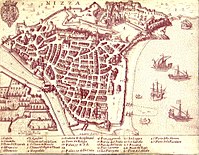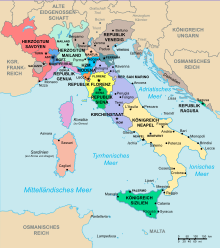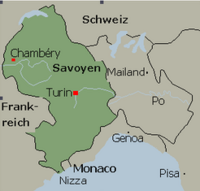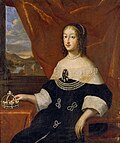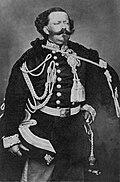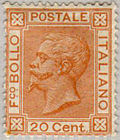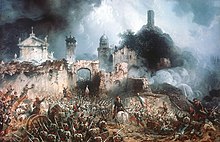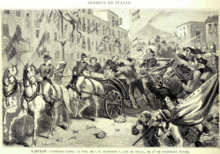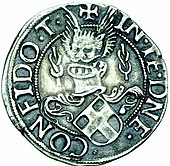House of Savoy

The House of Savoy is a dynasty that has ruled the territories of Savoy and Piedmont since the High Middle Ages and provided the kings of Italy from 1861 to 1946 .
At times, the ruling dynasty also ruled parts of western Switzerland , the county of Nice and Sardinia .
middle Ages
origin
The founder of the house is Humbert I. Biancamano (Humbert Weißhand), a feudal lord of uncertain origin, who was Count of Salmourenc in Viennois in 1003 , Count of Nyon on Lake Geneva in 1017 and Count of Aosta Valley on the eastern slope of the Western Alps in 1017 . In 1034 he received part of the Maurienne as a reward from Conrad the Salier for supporting his claim to the Kingdom of Burgundy . He also received the counties of Savoy, Belley , Tarentaise and the Chablais .
Rise of the Counts of Savoy in the High Middle Ages
With these territories, Humbert had three of the most important Alpine passes, the Mont Cenis , the Great St. Bernard and the Little St. Bernard . His son Otto married Adelaide in 1046, the eldest daughter of Ulrich-Manfred's Margrave of Turin from the Arduine family , who ruled, among other things, the counties of Turin , Auriate , Asti , Bredulo and Vercelli , which together include what is now the region of Piedmont and part of Liguria correspond. Humbert died in 1048. He was followed by his son Amadeus , after whose death the land passed to Otto. In this way Otto became ruler of territories on both sides of the Alps, a circumstance that was to have an important influence on the politics of the House of Savoy in 1860. After Otto's death in 1060 he was followed by his widow Adelaide, but before her death in 1091 his sons Peter I and after him Amadeus II became rulers of the county.
Under Humbert II (reign 1078-1080) there were first clashes against the Piedmontese municipalities, but he, his successor Amadeus III. (who died on the way home from the Second Crusade ) and Thomas I pursued a policy of reconciliation towards them. Thomas, who ruled until 1222, was Ghibelline and ensured a considerable increase in the importance of Savoy, because he was appointed imperial vicar and achieved important expansions of his territory, namely in Bugey , in Vaud , specifically in Payerne and Romont in 1240, and in Romainmôtier in 1272 (northwest of the Alps) as well as Carignano , Pinerolo , Moncalieri and Vigone (southeast of the Alps). He also ruled over Geneva , Albenga , Savona and Saluzzo . After his death these territories were divided among his sons: Thomas II received the Piedmont, Aimone das Chablais, Peter and Philip further fiefs , and Amadeus IV , the eldest, the county of Savoy and a general "supremacy" over the possessions of his brothers . Other brothers received episcopal offices outside their home countries, and Boniface finally became Archbishop of Canterbury .
Peter II traveled to England several times . One of his nieces, Eleonore de Provence , became the wife of King Henry III of England . , another, Sancha de Provence , wife of Richard of Cornwall . Heinrich made Peter Earl of Richmond and furnished him with a palace on the Thames , which was named Savoy Palace . Count Peter also gained additional territory in Vaud and defeated Rudolf von Habsburg near Chillon .
After Thomas II took several cities and fortresses in Piedmont, he lost them again and was temporarily imprisoned by the citizens of Turin . Of the sons of Thomas I, only he left male heirs. His son Amadeus V , called "the Great", ruled from 1285 to 1323 and is considered to be the "unifier" of the scattered areas of the house. When Amadeus assumed his reign, the fiefdoms were divided as follows: the county of Savoy became his own territory, the principality of Piedmont went to his nephew Philip and the Vaud was given to his brother Ludwig . Although this structure was formally confirmed in 1295 when Chambéry became the capital of Savoy, Amadeus nevertheless gained supremacy over all properties, which also led to political unification within the country. He won back fiefs that his predecessors had lost through conquests, purchases and skilful bargaining. In numerous campaigns he fought the Dauphins des Viennois , the Counts of Genevois , the citizens of Sion and Geneva, the Marquis of Saluzzo and Montferrat and the Barons of Faucigny . He also worked as a peacemaker between France and England and accompanied Emperor Henry VII on his Italian campaign .
Amadeus V was followed by his sons, Eduard the Liberal (1323–1329) and later Aimone the Peaceful (1329–1343). Aimone is considered to be one of the most capable princes of his family, having succeeded in reforming the administration and the judicial and financial systems of Savoy.
His son Amadeus VI. (Reign 1343-1383), called Il Conte Verde ("the green count"), followed him at the age of only nine years. Amadeus made a reputation for himself both as a crusader and in a campaign against the Ottomans , which he led in 1366. The Treaty of Paris of 1355 put an end to the tensions that had built up between it and the French royal family. The count wanted to acquire the Dauphiné, bordering on Savoy, but France had beaten him with a higher price and an accidental inheritance. In 1356, the Savoy was appointed vicar of the emperor's office. This enabled them to build up their territorial rule through jurisdiction, i.e. generally determine an area and its inhabitants and not, as in the feudal system , with individual concrete legal titles over certain groups of people. With his decision to give priority to the Italian possessions over those at the foot of the French Alps and those in western Switzerland , Amadeus VI. a development that was to become of great importance for the Savoy dynasty. He mediated between Milan and the House of Montferrat (1379), between the Scaliger and Visconti families, and between the republics of Venice and Genoa after the Chioggia War (all 1381). Amadeus was one of the first sovereigns to introduce a system of free legal advice for the poor. When he actively supported Ludwig von Anjou in his claim to the Kingdom of Naples , he died of the plague during the campaign in Campobasso .
His son Amadeus VII , called Il Conte Rosso , ("the red count") ruled from 1383 to 1391. In his youth he took part in a campaign in Flanders alongside Charles V of France . In 1388 he succeeded in conquering the county of Nice, giving Savoy access to the Mediterranean . In the same year the count lost the battle of Visp against the Confederates in Upper Valais .
The Dukes of Savoy in the Late Middle Ages

During the long reign of Amadeus VIII (1391–1440), son of Amadeus VII, Savoy experienced a heyday. The count was able to round off his territories both in the Lake Geneva region ( Pays de Gex ) and in Italy (Piedmont). In 1416 King Sigismund visited him in Chambéry and made him duke . In 1430 Amadeus introduced the Statuta Sabaudiæ , a comprehensive code of law that was valid for the entire duchy, against the opposition of the nobility and the cities, which saw their privileges in danger . In 1434 the Duke retired to the Ripaille Charterhouse on Lake Geneva, where he continued to work in the background and act as mediator while leaving the day-to-day business to his son Ludwig . Although Amadeus did not belong to the clergy , he was surprisingly elected "Holy Father" at the Council of Basel in 1439 against the incumbent Pope Eugene IV . He served as antipope under the name Felix V for ten years , until he resigned and only retained the cardinal dignity . Felix's adversary, Pope Eugene IV, demonized the Duchy of Savoy (and there especially the high valleys in Wallis, Vaud, in the Savoy Alps and in the Aosta Valley) as a hoard of witches in a bull of 1440 , using the terms witch, heretic and Waldensians were mixed. According to the historian Wolfgang Behringer , the first massive witch hunts in Europe took place around 1428 in Savoy.
Amadeus' son Ludwig (reigned 1440–1465), who was the first to bear the title of Prince of Piedmont , was unable to build on the political and diplomatic successes of his father. He married Anne de Lusignan in 1433 from the Lusignan house that ruled Cyprus at the time . As a result, Ludwig had to endure the intrigues of his wife's Cypriot court as well as the ambitions of his French and Milanese neighbors. In 1446 he had to cede Valentinois to the French crown. Access to Milan, where the Visconti family died out in the male line in 1447, failed. When Amadeus was offered the Principality of Monaco by Jean I in 1448 for an annual pension, he turned it down for fear of the enemies in Nice and Turbia . In 1452 Freiburg im Üechtland , which had exhausted itself heavily in the Old Zurich War , renounced Habsburg and placed itself under the protection of the Duke, who forgave the city all war debts. The last years of his reign were marked by conspiracies by the nobility, in which his youngest son Philipp de Bresse was also involved.
Ludwig was succeeded by his son Amadeus IX. ( Reign 1465–1469), who because of an epileptic illness, the reign in 1469 of his wife Yolande , a sister of the French king Louis XI. , left. This shift in power triggered a civil war in Savoy between the French and Burgundian partisans, because both the French king and the Burgundian Duke Charles the Bold , who pursued an expansive policy, tried to win Savoy as their ally. Finally, in 1475, Yolande decided against her brother and in favor of Karl; a momentous choice, because it pulled Savoy right into the middle of the Burgundian Wars . The Duke of Burgundy was in conflict with the ambitious Confederates and was defeated by them in several battles that also affected Savoyard territories (see Battle of the Planta ). In 1476, Yolande had to cede parts of Vaud to Bern and give up her rights over the Valais and Freiburg in Üechtland. This marked the beginning of the decline of Savoyard power in what is now western Switzerland.
Designated successor to Amadeus IX. was Philibert I , who died at the age of 17 and was represented by his mother Yolande. It was she who see him as 11-year-olds with the wealthy Milanese duke's daughter Bianca Maria Sforza married, the third wife of the later Holy Roman Emperor Maximilian I should be. Charles I , who was also a minor at the age of 14 (reigned 1482–1490), followed as ruler of Savoy . He was Philibert's younger brother and was brought up at the French court. Inside, Charles prevailed against insubordinate nobles and in 1487, against the resistance of France, he succeeded in subjugating the margravate of Saluzzo in the Piedmont region. Philibert died young and for the only 21-month-old successor Charles II , mother Bianca von Montferrat ( Blanche de Montferrat ), who resided in Turin and not in Chambéry, took over the reign. Karl died in 1496 at the age of seven in a fall from his bed. Heir to the throne was his great-uncle, Philip II.
Modern times
Italian Wars - Savoy under French occupation
Formally, Savoy still belonged to the Roman-German Empire; but after Amadeus VIII had surprisingly withdrawn in 1434 and embarked on a spiritual career, the duchy became dependent on France and, in the long run, also in the major conflict between Habsburg and France over hegemony in Italy, which the first half of the 16th century should shape.
Philibert II grew up at the French court and, after numerous deaths in quick succession within the House of Savoy, became young and, above all, unexpectedly duke (1497–1504). After a short marriage with his underage cousin Yolande de Savoie , who soon died, he married Margaret of Austria . She was the daughter of the Roman-German Emperor Maximilian I from the House of Habsburg and his first wife Maria of Burgundy , the only natural heiress of the Duchy of Burgundy , which has since been dissolved and divided between Habsburg and France. Margarete also served as governor of the Burgundian Netherlands . During Philibert's reign, the French King Louis XII conquered . the Duchy of Milan (see Italian Wars ). Savoy was thus embraced by France both in the west and in the east. The prevailing constellation - marriage of an Austrian princess on the one hand and France's expansive policy in northern Italy on the other - led Savoy to turn away from France and instead to establish friendly relations with Austria. Philibert II, who liked to indulge in pleasure, was strongly influenced by his wife. He died young and without an heir in a hunting accident.
In 1504 Charles III followed. , Half-brother . Of Philibert II, he repeatedly changed his allies: once he was with his nephew of France, the king I. Franz , then again with his brother , the Emperor of the Holy Roman Empire and King of Spain , Charles V , dating. These two parties waged a bitter war against each other for supremacy in northern Italy. Francis I also claimed the Savoyard territories of Bresse and Faucigny as an inheritance for his mother Luise of Savoy . In Geneva the citizens rose against the nobility . They pursued the goal of uniting their city with parts of the Genevois and the Pays de Gex and forming this structure into a republic . The so-called spoonbands , a union of nobles loyal to the duke, whose concern was to maintain the power of Savoy in Bresse, Faucigny and Geneva, was left to its own devices at the decisive moment and received no support from the duke. In 1536, French troops overran the western border of Savoy and the two main towns of the Duchy of Chambéry and Turin were captured. Almost at the same time, Bernese troops under Hans Franz Nägeli, with the help of their Friborg and Valais allies, drove out the supporters of the Spoonbill from Geneva and Vaud, because Duke Charles III had met in Geneva. created many enemies by his arrogant and thoughtless demeanor. The Geneva patricians blamed the Savoyard for the economic collapse of the city: The once profitable Geneva trade fairs have sunk to a regional market because the city lacks the necessary protection. That could only mean that Geneva had to seek salvation in the style of Bern. Ultimately, all that remained for Karl was to flee to Vercelli in Piedmont . There he remained - practically in exile - until his death in 1553. Between 1536 and 1559 large parts of the Duchy of France were occupied and parts of the Upper Rhone Valley , including the city of Geneva, were effectively lost to the Confederates.

Son and successor Emanuel Philibert (reign 1553-1580) tried hard to win back the duchy, which he finally succeeded. As the Hereditary Prince , Emanuel Philibert, expelled by the French, became one of the most important generals of the Roman-German Emperor. In 1547 in the Schmalkaldic War he served Charles V, who appointed him governor of the Habsburg Netherlands in 1556 . When the Italian war under the Spanish King Philip II attacked the border region between France and Flanders, the French were defeated in 1557 by the Spaniards led by Emanuel Philibert in the battle of Saint-Quentin . Thanks to this triumph, the Duke secured a seat at the conference table during the peace negotiations. In the Treaty of Cateau-Cambrésis he was able to enforce the independence of Savoy in 1559 and he came back into possession of most of his ancestral territories. The simultaneously arranged marriage between the Duke and Margaret of France , daughter of the late King Francis I and sister of the reigning French monarch Henry II , also contributed to the settlement of the conflict between France and Savoy . In 1561, Emanuel Philibert signed the Edict of Rivoli , which replaced Latin as the official language in his domain with French (northwest of the Alps) and Italian (southeast of the Alps). In 1563, Emanuel Philibert moved the capital of the Duchy of Chambéry to Turin. In 1565 the politically isolated Bern was forced to return the Pays de Gex and the Chablais to Savoy. Geneva, on the other hand, was lost to the duchy. Emanuel Philibert's attempt to succeed his deceased uncle Henry I of Portugal in 1580 quickly proved to be a hopeless undertaking; Ultimately, the Portuguese crown went to Philip II.
The House of Savoy shifts its center of gravity to Piedmont
In 1559 the battles between Austria / Spain and France for supremacy in Italy came to an end for the time being. In the Peace of Cateau-Cambrésis they agreed on a political order for the Apennine island that lasted until the War of the Spanish Succession .
Emanuel Philibert had created a respectable army that was further developed by his successors and established Savoy's relative strength well into the 19th century. With the exception of Venice , the other Italian states were henceforth militarily insignificant and could therefore no longer play a role on the international level. The Spanish absolutism that dominated Italy was static. It guaranteed tranquility on the peninsula and protected it from Turks and barbarians , but, unlike Western European absolutism, it prevented economic modernization and civic activities on a larger scale.
Emanuel Philibert was followed by eighteen-year-old Karl Emanuel I (reign 1580–1630), also known as the Great , who grew up to be an ambitious and self-confident ruler. In 1585 he married Catalina of Spain , the second daughter of the Spanish King Philip II. Karl Emanuel took advantage of the weakness of France while it was busy with the Huguenot Wars in the interior and in 1588 conquered the margraviate of Saluzzo in Piedmont. In 1601 France recognized the Savoyard rule over Saluzzo in the Treaty of Lyon , but received the areas of Valromey , Bugey, Bresse and the Pays de Gex in exchange . The recapture of the Calvinist “heretical nest” Geneva was a high priority for the Duke in his long reign, and it actually became an obsession. In 1602, Karl Emanuel sent his mercenaries to Geneva in the so-called Escalade de Genève , but the city was completely unsuccessful. In the Peace of Saint-Julien in 1603, the Duke recognized the independence of the city on the Rhone, which had long been opposed for political and religious reasons. The Treaty of Bruzolo , concluded in 1610 with the French King Henry IV. , Which dealt with a Franco-Savoyard alliance against the Habsburg-Spanish supremacy in northern Italy, did not come into force for the time being, as the king was murdered shortly afterwards. However, when his successor Ludwig XIII. reached the age of majority, the Duke received French support in 1617 in the reconquest of Alba in Piedmont and his son Viktor Amadeus was married to Ludwig's sister Christina in 1619 . The ambitious and risky Karl Emanuel I waged war between 1613 and 1617 to win the Duchy of Mantua or at least the Margraviate of Montferrat , but met with resistance from Spain, Austria and Venice and in the end had to be happy that he had a peace without territorial ones Made losses. In the meantime the Thirty Years' War had broken out, in which the hereditary dispute over the Duchy of Mantua (1628–1631) was a secondary theater of war. In this dispute, Karl Emanuel showed himself to be an unreliable partner: first he allied himself with Spain, but soon afterwards with France and a little later he declared himself neutral. In 1630 Cardinal Richelieu put an end to the duke's tactics and had Savoy-Piedmont taken by a French army. Karl Emanuel died unexpectedly of an acute fever in the same year.
His son Viktor Amadeus I (reign 1630–1637), who had spent most of his youth at the Spanish court in Madrid , inherited him in little more than the title of duke. His father's policy had shattered relations with France as well as with Habsburg. In 1631 the Duke had to sign the Treaty of Cherasco , vanquished , which ended the War of the Mantuan Succession, and under the directive of Cardinal Richelieu, the Treaty of Rivoli was concluded in 1635 , in which Victor Amadeus was obliged to form an anti-Habsburg coalition in northern Italy. There he achieved two victories: in 1636 in the Battle of Tornavento and in the Battle of Mombaldone . In the same year Viktor Amadeus died in Turin.
After the death of Viktor Amadeus I, his wife Christina of France (de facto reign 1637–1663), sister of the French King Louis XIII, took over the guardianship of the two sons Franz Hyazinth (1632–1638) and Karl Emanuel II (1634– 1675) and with it the reign of Savoy-Piedmont. The two younger brothers of his predecessor Viktor Amadeus I and his wife Katharina Michaela of Spain Moritz von Savoyen and Thomas von Savoyen embroiled the widow in a four-year war of succession . They feared that the French crown could maintain and expand dominance over Savoy-Piedmont. In 1638 Thomas asked for help in Madrid for his and his brother's ambitions, but the Spaniards reacted hesitantly and finally the plot was uncovered by the French. Cardinal Richelieu issued an arrest warrant against Thomas in 1639, but he did not return to Piedmont as a private person, as expected, but accompanied by a mercenary force supported by Spain. This was the trigger for the Piedmontese civil war , in which Christina, with French help, finally got the upper hand. In the peace treaty of 1642, she forced her fifty-year-old brother-in-law Moritz to give up the cardinal dignity and to marry her only fourteen-year-old daughter Ludovica Cristina of Savoy . But later it turned out that Christina was very careful with all this to curb France's influence on Savoy-Piedmont.
Charles Emanuel II (de facto reign 1663–1675) took over the rule only at the age of twenty-nine after the death of his mother. As Hereditary Prince, he rigorously persecuted the Piedmontese Waldensians , which in 1665 resulted in a massacre of those of different faiths. The brutal approach in this matter called on the English regent Oliver Cromwell , who sent his negotiator Samuel Morland to northern Italy to assist the Waldensians. In 1672/1673 the duke waged war against Genoa, but failed to achieve his goal of gaining access to the Mediterranean in Liguria. In general, however, he managed to revive trade and increase the economic weight of the duchy. He expanded the port of Nice and had an old Alpine crossing built in the direction of France through the Chartreuse Mountains , the so-called Chemin des Grottes des Échelles near Saint-Christophe-la-Grotte. A large monument erected in 1674 on this street commemorates the duke. He abolished the mercenary system and replaced it with a standing army equipped with cavalry , infantry and uniforms. His mother Christina had commissioned the construction of the Palazzo Reale in Turin in 1645 . Karl Emanuel II died in the capital in 1675.
Savoy-Piedmont defies the hegemony of France

• Principality of Piedmont with the capital Turin,
• Duchy of Savoy , • County of Nice , • County of Aosta
He was followed by his only son Viktor Amadeus II (effective reign 1684-1730). His minority was bridged with the reign of his capable but authoritative mother Maria Johanna von Savoyen , called Madame Royale (effective reign 1675–1684). At her instigation and that of the French King Louis XIV , Viktor Amadeus married Anne Marie d'Orléans , a niece of the "Sun King", in 1684 . In the same year, the eighteen-year-old duke urged his mother to resign in order to take the fate of Savoy-Piedmont into her own hands. Louis XIV, who treated his nephew Viktor Amadeus almost like a vassal - although the duchy was actually part of the Holy Roman Empire - obliged the duke to persecute his Waldensian subjects, many found in (reformed) Switzerland. At the beginning of the Palatinate War of Succession , Viktor Amadeus joined the Augsburg League (a defensive alliance of Austria, Spain and the Republic of Venice against the hegemony of France) in 1690 . In the same year, the Duke was defeated in the bloody battle of Staffarda by General Nicolas de Catinat . As a result, the French army overran large parts of Savoy-Piedmont; however, the capital Turin remained under the control of the duke. In 1692 Viktor Amadeus penetrated the Dauphiné in a retaliatory action and devastated large areas there. In 1693, the French defeated the Savoy army again in the Battle of Marsaglia , and as a result the Duke was forced to withdraw from the Augsburg League. In 1696 he had to come to an understanding with France in the treaties of Turin and Vigevano . The War of the Palatinate Succession ended in 1697 with the Peace of Rijswijk . The War of the Spanish Succession followed in 1701 , in which the duke first sided with France and Spain. But the House of Savoy had long since grown weary of French tutelage and could not have expected any advantage from France and Spain if they had won. This moved Viktor Amadeus to join Austria in 1703, but with which he exposed himself to a two-front war, which was driven both from France and from the Spanish Duchy of Milan . The siege of Turin began in 1706, but in the battle of Turin , which was unquestionably fateful for the House of Savoy , Viktor Amadeus was victorious, thanks in particular to the military support of his cousin Eugene of Savoy , who was in the service of Austria. The French suffered heavy losses in this battle and were driven out of the country. In 1708 Viktor Amadeus conquered the margraviate of Montferrat and thus obtained the long-sought access to the sea in Liguria. From 1709 the duke declared himself neutral. During the Peace of Utrecht , which ended the War of the Spanish Succession, Savoy-Piedmont was one of the beneficiaries of the European upheavals: the Duchy received back the territories previously occupied by France and remained unmolested in France until the end of the Ancien Régime .
Recent history
Kings of Sardinia
absolutism

With the Treaty of Utrecht , the so-called secondary lands of the Spanish were divided up in 1713. In the process, Savoy-Piedmont received, in addition to the western outskirts of the Duchy of Milan , especially Sicily . Since this island was outside the Holy Roman Empire, this made it possible for Viktor Amadeus to be raised from Duke to King. The House of Savoy was the first and only genuinely Italian kingdom after antiquity. In keeping with the zeitgeist of the time, the monarch crowned in Palermo ruled in an absolutist way over his extended empire. Sicily could not be asserted, however: In the Treaty of The Hague of 1720 Charles VI came. von Habsburg and Viktor Amadeus agree to swap the islands of Sicily and Sardinia (see War of the Quadruple Alliance ), with which the latter became master of the Kingdom of Sardinia- Piedmont. The rulers of the House of Savoy carried the title of Kings of Sardinia from then until the founding of the Kingdom of Italy . Viktor Amadeus resigned in 1730 in favor of his son Karl Emanuel III. and retired to his castle in Saint-Alban-Leysse near Chambéry . Mentally confused in old age, he tried again to regain the crown, but his son had him arrested. In 1732 he died as a prisoner in the monastery of San Giuseppe di Carignano . During his tenure, the Stupinigi Castle and the Superga Basilica were built .

Charles Emanuel III. (Reigns 1730–1773) took part in the War of the Polish Succession against Austria on the French side . For his victory at Guastalla in 1734 he was rewarded with the Duchy of Milan, which he had to surrender in the Preliminary Peace of Vienna in 1736 , although he was allowed to keep the cities of Novara and Tortona . In the War of the Austrian Succession in 1742 he sided with Maria Theresa of Austria . After France had temporarily conquered Savoy and the county of Nice, he managed to decisively defeat the French in the Battle of Assietta in 1747 . With the Peace of Aachen in 1748 , which followed the defeat of France, he gained an area in the Po Valley , including the city of Vigevano . He decided not to take part in the Seven Years' War and instead preferred to push ahead with internal reforms, with the newly acquired Sardinia in particular having some catching up to do. There he relaunched the universities of Sassari and Cagliari . In Chambéry he set up an office that developed one of the first land register plans of its time, the so-called Mappe Sarde ; Jean-Jacques Rousseau worked briefly for this office. Karl Emanuel's state, the Kingdom of Sardinia , unofficially also called Sardinia-Piedmont (in France also États de Savoie ), was still ruled from Turin in Piedmont.
French Revolution and Napoleon I.
He was followed by his son Viktor Amadeus III. (Reigned 1773–1796), who is described as conservative and deeply religious. When the French Revolution broke out in 1789, he sided with the royalists and came into conflict with the French Republic . In 1792, before the Napoleonic campaigns, the revolutionary government - citing the principle of "natural borders" - claimed Savoy as the 84th department of France and provisionally assigned it the name Mont Blanc (today the departments of Savoie and Haute-Savoie ) . Viktor Amadeus then declared war on France. Savoy and the county of Nice were quickly occupied by the French Revolutionary Army. In 1793, after a referendum , the county of Nice became the French department of Alpes-Maritimes . East of the Alps, on the other hand, the Piedmontese - with military support from Austria - were able to hold their own against Napoleon's Italian army for four years . In 1793 the king donated the Italian medal for bravery ( Medaglia d'oro al Valore Militare ). Then in 1796 three battles were lost in quick succession, namely the battle of Montenotte , the battle of Millesimo and the battle of Mondovì ; then France proclaimed the short-lived republic of Alba in Piedmont. With the Cherasco armistice of 1796, the Italian lands returned to Viktor Amadeus, but the Sardinian king was forced to withdraw from the first coalition . In the same year Viktor Amadeus III died. a stroke. He left a kingdom with an empty treasury, and the two important countries of Savoy and the county of Nice were annexed by France and devastated by war.
His son and successor Karl Emanuel IV (reign 1796-1802) had to flee to Cagliari in Sardinia, because the French under Joubert in 1798 had reoccupied Piedmont. The Piedmont Republic was proclaimed in Turin on December 10, 1798 . While Napoleon was on the Egyptian campaign and the Austro-Russian armies were able to make good ground in northern Italy in 1799 (see second coalition ), Charles Emanuel IV landed in Livorno in the hope of regaining at least part of his mainland possessions. But Napoleon returned and maintained his position in Italy with a brilliant victory in the Battle of Marengo in 1800, creating the Subalpine Republic , which remained under French military administration until it was annexed to the French Republic on September 11, 1802, divided into the departments Doire , Marengo , Pô , Sesia , Simplon and Stura . Karl Emanuel abdicated in 1802 in favor of his brother Victor Emanuel I , not least because of the death of his wife, Clotilde de Bourbon in the same year, a sister of the French King Louis XVI, who had meanwhile been guillotined . The couple had no children. In 1815 Karl Emanuel joined the Jesuits and lived in Rome until his death .
restoration
Viktor Emanuel I (reign 1802-1821) got his lands back on the mainland after the fall of Napoleon in 1814 and in 1815 at the Congress of Vienna he also got the Republic of Genoa, which was annexed to the Kingdom of Sardinia as the Duchy of Genoa . The city of Genoa became the seat of the navy. In 1816, with the Treaty of Turin, the Kingdom of Sardinia ceded some municipalities in the province of Carouge to the Swiss canton of Geneva. This meant that the relevant agreement of 1754 became obsolete. Victor Emanuel acted entirely in the spirit of the Restoration : he revoked the Code Napoléon in his country, restored both the nobility and the clergy with the traditional privileges and lands, and resumed persecution of the Waldensians and Jews. His anger at the disgrace which the House of Savoy had to endure during the turmoil of the revolution was so strong that he had a bridge over the Po and a road over the Mont Cenis, both built under the French occupation, torn down. The reactionary attitude of the king displeased the people and so it came to an uprising orchestrated by the secret society Carbonari in Piedmont. In this way, isolated, Viktor Emanuel felt compelled to abdicate in 1821 in favor of his brother Karl Felix .

The designated King Karl Felix (reign 1821-1831) stayed at the same time in Modena . The masses therefore stormed Prince Karl Albert , nephew of Viktor Amadeus I, to take over the head of the state for the time being. Only after many requests did he declare that he was ready and, with the Italian tricolore ( il tricolore ) in hand, proclaimed the acceptance of the Spanish constitution . With the support of 20,000 Austrian soldiers, Karl Felix then marched towards Turin and put down the uprising in Piedmont. Under the protection of the Habsburg soldiers, who remained in the country until 1823, the full reaction began . The Waldensians were forced to sell their properties and emigrate until 1827. A royal edict of 1825 permitted reading and writing only to those with a fortune of 1,500 lire and only granted permission to study to those with an income of more than 1,500 lire. In 1824 Karl-Felix acquired a large collection of ancient Egyptian artefacts from the consul Bernardino Drovetti , which form the basis of the Museo Egizio in Turin. With Karl Felix's death in 1831, the main line of the House of Savoy also died out.
Unification of Italy
Karl Albert (1831–1849)
Karl Albert from the Savoy-Carigano branch , which emerged from Thomas , the youngest son of Karl Emanuel I , ruled the Kingdom of Sardinia for a short time as early as 1821. The liberal-minded exponent of the House of Savoy-Carigano, who grew up in an intellectual atmosphere in Dresden , Geneva and Paris, took over the affairs of state again in 1831. For the time being, he focused on continuity and continued the conservative policies of his predecessor. He suppressed the liberals and entered into a military alliance with Austria. Little by little, under pressure from the strengthened bourgeoisie , he resumed the course of freedom that had been cultivated in his youth. In 1837 he introduced a civil code based on the Civil Code and revised the criminal law . After the February Revolution of 1848 , on March 4, 1848 , he issued the so-called Statuto Albertino and appointed Cesare Balbo his prime minister . The Kingdom of Sardinia thus became a constitutional monarchy , with the line of succession based on the Lex Salica . This constitution remained in effect until 1946 and thus survived the transformation of the Sardinian to the Italian kingdom. The Albertino statute as such was only moderately liberal with very limited parliamentary rights of participation and monarchical-executive power. With the lettere patenti of March 18, 1848, the Waldensian minority received religious freedom , full civil rights and equality before the law; many of their relatives played a major role in the liberal bourgeoisie of the kingdom in the years that followed.
In other parts of Europe, too, popular uprisings against the restoration of absolutism spread in 1848 . But in Italy and in other areas ruled by the Austrian Empire , the main issue was national self-determination. In the Kingdom of Lombardy-Venetia a burst Revolution and also in the Grand Duchy of Tuscany uprisings. The independent Kingdom of Sardinia was then asked from many sides in Italy to take the lead in the unification movement and to use the moment to end Austrian rule in northern Italy. Thereupon Karl Albert, influenced by Cavour , declared war on the Danube Monarchy. The Piedmontese army joined 7,000 men from Tuscany, 10,000 soldiers were from the Papal States provided 16,000 from the Kingdom of Naples. After initial successes in the Battle of Pastrengo and the Battle of Goito , the conservative forces regained the upper hand, and Sardinia was defeated by Austria in the Battle of Custozza in 1848 and in the Battle of Novara in 1849 , bringing the first Italian War of Independence to an end took. A huge war indemnity was imposed on Sardinia-Piedmont to cripple it permanently. Karl Albert then abdicated in favor of his son Victor Emmanuel II and went into exile in Portugal, where he died soon afterwards.
Karl Albert supported art and science. Under his reign, the textile industry (raw silk, cotton, wool in Biella ) and the chemical industry in Turin took off. From 1848 one of the first railway lines in Italy connected the two cities of Turin and Moncalieri . In 1838 there were 4,650,368 inhabitants in the Kingdom of Sardinia, of which 524,633 lived on the island.
Victor Emanuel II. (1849–1861 / 1861–1878)
Under Victor Emanuel II (also called Padre della Patria "Father of the Fatherland"), eldest son of Karl Albert, Italy was unified. He was by his Prime Minister Cavour and the French Emperor Napoleon III. supported.
After the Sardinian defeat at the Battle of Novara, the King undertook to pay Austria 75 million French francs in compensation in the Vignale armistice in 1849 . At this point, Victor Emmanuel had already become a symbol of the Risorgimento . In the years 1853 to 1856 he took on the side of France, Britain and the Ottoman Empire against Russia on the Crimean part and was able to present themselves in the ranks of the major European powers and prove. In addition, the development towards liberalization and modernization continued inside; Under the Prime Ministers Massimo d'Azeglio and Camillo Benso Conte di Cavour , the separation of Church and State was introduced, the property of the Church was nationalized and the influence of Catholic orders such as the Jesuits was limited.
In the secret treaty of Plombières-les-Bains in 1858 Cavour secured the aid of Napoleon III in the event of an Austrian attack on Sardinia-Piedmont. France was to support Victor Emanuel at the price of the Duchy of Savoy and the county of Nice in obtaining the crown of Italy, whereby it was also agreed that Sardinia-Piedmont would have to bear the war costs. In order to achieve this goal, Austria should be provoked to a military first strike in northern Italy, which Napoleon III. there would be a suitable pretext for intervening on the Sardinian side. On January 1, 1859, at the New Year's reception of the foreign diplomats, the French Emperor addressed the Austrian Ambassador as follows: “I regret that relations between my government and the Austrian are not as good as they used to be, but I ask you to tell your emperor that my personal attitudes towards him have not changed. ”In the language of diplomacy at the time, that was a declaration of war that was immediately answered with a general stock market crash. Victor Emmanuel became even clearer when he opened the session of the Sardinian Parliament on January 10th of the same year with the following words: “The horizon on which the New Year is approaching is not entirely bright. We are not insensitive to the cry of pain that echoes from so many parts of Italy. "
The elaborate plan came true: On April 29, 1859, under the command of Count Gyulay, the Austrians marched into Piedmont in three places. On June 24, 1859, in the bloody battles of Solferino and San Martino , the Austrian army was defeated by France and Sardinia. The Peace of Zurich on November 10, 1859 ended the Sardinian War . Austria was obliged to surrender Lombardy to France, and Napoleon III. passed the province on to Sardinia. The House of Habsburg also had to accept that other Italian possessions were lost: both Grand Duke Leopold II of Tuscany and Duke Franz V of Modena were deposed in referendums in the following year, and Italy was unified into a nation state. To Cavour's disappointment, Veneto remained with Austria. In the Treaty of Turin in 1860 was between Napoléon III. and Victor Emmanuel completed the annexation of the Duchy of Savoy and the County of Nice to France. The Switzerland that France hochsavoyardischen demanded areas Chablais and Faucigny, was the so-called Savoyerhandel nothing. Finally, on March 17, 1861, Victor Emmanuel was officially proclaimed King of Italy.
After the third Italian War of Independence in 1866, Italy was awarded Veneto. On March 26, 1860 Victor Emanuel and all his descendants were by Pope Pius IX. excommunicated . When Napoleon III, who had come to power not least thanks to the support of the Catholic Church in France, withdrew his protection troops from Lazio as a result of the beginning of the Franco-Prussian War in 1870 , the Italian military marched into Rome almost without a fight. The Vatican responded with a policy of isolation from everything worldly. As a result, the new Italian state was in conflict with the influential Catholic Church for decades, until the Lateran Treaty of 1929. Victor Emanuel II died in Rome in 1878.
Kings of Italy
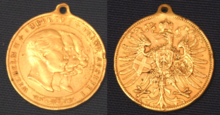
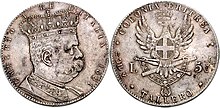
Umberto I (1878-1900)
After Viktor Emanuel's death in 1878, his eldest son Umberto I (Humbert I) became king. He went through military-oriented training and took part in the Battle of Solferino in 1859 and in the third Italian War of Independence in 1866. After the conquest of Rome in September 1870, he was given command of the military divisions there as lieutenant general . Because of the revolts against numerous Italian dynasties, which had brought about the unification of Italy, and because of the bad relations between the House of Savoy and the Pope, only a few royal houses were willing to establish relations with the newly formed Kingdom of Italy. After all, Umberto joined the Triple Alliance in 1882 and also tried to break away from his foreign policy isolation with regular visits to Vienna and Berlin , which many Italians observed with skepticism, as Austria still retained Italian-speaking areas ( Trentino , Istria and Trieste ) were claimed as "unredeemed" Italian territories by the young nation-state in the context of irredentism .
When Umberto made a tour of Italy in the year of his coronation in 1878, he was the target of an assassination attempt in Naples . But because he was able to parry the blow directed at him with his saber, he was only slightly wounded by the attacker, the anarchist Giovanni Passannante .
The colonial expansion of Italy began under Umberto . His armed forces occupied Massaua in 1885 as the first place in Eritrea, which became the capital of the colony of Eritrea . Since Umberto also became militarily active in Somalia in 1889 , it was said that the Italian king was aiming to establish a large empire in northeast Africa. In any case, the catastrophic defeat of the Italian invading troops in the Battle of Adua in Abyssinia in 1896 dampened his ambitions in this regard. In the summer of 1900, the Italian Navy took part in the suppression of the Boxer Rebellion in the Empire of China as part of the Eight Nations Alliance . This resulted in a trading concession for Italy in the Chinese city of Tianjin .
During the colonial wars, numerous tumults broke out in Italy because of the high prices of bread, including in Milan in 1898. The northern Italian metropolis was then placed under military control. Its commander, Fiorenzo Bava Beccaris , had demonstrators shot over a large area, with the devastating result that, depending on the information, between 82 and 300 people died and many were injured. The commander was later decorated with the Savoyard Cross of Merit for his service. Umberto was murdered on July 29, 1900 by the Italian-American anarchist Gaetano Bresci in Monza with several revolver shots. According to the assassin himself, he wanted to avenge the “Bava Beccaris massacre” in Milan.
Victor Emmanuel III (1900-1946)
Umberto I was followed by his only son Viktor Emanuel III. Born in Naples, he was called the Little Prince of Naples during his father's lifetime . Even in adulthood, Viktor Emanuel was noticeably short, measuring only 1 meter 53. Although his government survived two world wars - although it should be noted that between 1923 and 1943 he had hardly any political weight - his “imperial dreams” failed because of reality and his passive and opportunistic attitude towards Mussolini ultimately led to the dissolution of the monarchy in Italy and thus to the end of the House of Savoy as a ruling dynasty.
1915 joined Italy at the side of the Entente in the First World War one. In a daily order to the troops, Victor Emanuel shared the optimism of his Chief of Staff Luigi Cadorna . He believed that he could conquer Trieste with his troops within a month and then be in a good position to overrun Vienna. As a result, the Alpini got involved in crazy battles in the White War , which were often fought at an altitude of over 3000 meters.
Although Italy was awarded South Tyrol and Trentino in the Treaty of Saint-Germain , at the end of the First World War Italy was dissatisfied with what had been achieved and felt that the great powers were taking too little seriously; one therefore spoke of a "mutilated victory" (vittoria mutilata) . Italy's participation in the victory in the "Great War" was paid too dearly with around 680,000 dead, with economic and financial bankruptcy and excessive nationalism .
Italy went through one parliamentary crisis after another from 1919 onwards, and in the early 1920s the domestic political struggles between the Marxist -minded “Reds” and the fascist -influenced “ Black Shirts ” led to conditions similar to civil war . During this crisis, Victor Emanuel conferred with his Chief of Staff Armando Diaz , the latter saying to the king: "Your Majesty, the army will do its duty, but it would be best not to put it to the test." Thereupon Viktor Emanuel refused in 1922 Signature of the emergency decree drawn up by his Prime Minister Luigi Facta , with which the latter wanted to oppose the march on Rome organized by Mussolini's fascists . On October 30, 1922, the King appointed Mussolini as head of government. From then on, “the Duce” could not only count on the support of the military, the right-wing extremists with their racial laws and big business, but also on the tolerance of the Italian king. This also manifested itself in 1925 during the Matteotti crisis , in which Mussolini in fact completely disempowered parliament and Victor Emanuel issued a very dubious pardon.
In 1935/36 the Italian army conquered Abyssinia in a very bloody war and Victor Emanuel was proclaimed Emperor of Abyssinia . He held this office until the country was liberated in 1941 by Ethiopian partisans and British troops. In 1939 the Italian Mediterranean Fleet invaded the almost defenseless Albania and drove out the reigning King Ahmet Zogu . Victor Emanuel found the invasion of Albania with its rocky cliffs in the run-up to the conquest as "too daring" and "not very rewarding" - the monarch, whom Mussolini had called "idiot" after this assessment, accepted the crown of Albania and did kept them until the Wehrmacht took over the function of the occupying power in Albania in 1943. An attempted assassination attempt on Viktor Emanuel by the young Albanian patriot Vasil Laçi failed in Tirana in 1941 .
On June 10, 1940, when the German victory in the Battle of France was in sight, Italy, although poorly armed, officially entered World War II on the side of the Axis powers . Victor Emanuel recognized Mussolini's declaration in this regard, even if only half-heartedly. 1943, with the Italian campaign of the Allies , the fascist system in Italy collapsed. Viktor Emanuel had Mussolini, who had become unpopular, arrested and took over command of the Italian armed forces. He fled to Brindisi in order to avoid being captured by the Wehrmacht who had advanced in northern Italy .
In self-knowledge that he Fascist regime had been close, Viktor gave Emanuel in April 1944, most state business to his son and Crown Prince Umberto II. Nonetheless, forced the Italian people, initiated by the US occupying power, within the next year a referendum on the abolition of the monarchy. With his official abdication on May 9, 1946 in favor of Umberto, Viktor Emanuel tried to influence the upcoming vote in this regard. But it didn't help: the plebiscite was accepted with 53% of the votes and Victor Emanuel went into exile in Alexandria that same year , where he was received by the Egyptian King Faruq . He died in Alexandria in 1947.
Umberto II (1946)
Crown Prince Umberto II , son of Victor Emmanuel III, was born in 1904. He received military training. In 1929, on the day on which he wanted to officially announce his engagement to the Belgian Princess Marie José of Belgium , he was the victim of an attempted assassination in Brussels , in which, however, he was unharmed because the pistol shot missed the target. The perpetrator Fernando de Rosa was an anti-fascist and an avowed member of the Socialist International .
On May 9, 1946, Umberto took over the affairs of state from his father, but for just over a month. With the announcement of the referendum result on June 18, Umberto II was officially deposed and the monarchy in Italy ended. Umberto went into exile in Cascais , Portugal, refusing to acknowledge the defeat of the monarchy.
The Republican Constitution of Italy, which came into force on January 1, 1948, forbade the king, male descendants of the House of Savoy and their wives from returning to Italy. Their property fell to the state. In 1983 Umberto fell seriously ill and President Sandro Pertini wanted to allow him to enter Italy so that he could have died in his home country. Ultimately, Umberto traveled to Geneva that same year, where he died. No Italian government official attended the funeral.
today
In November 2002 the Italian Parliament amended the Constitution: the Savoy family was allowed to return to Italy. Viktor Emanuel (* 1937 in Naples), the only son of Umberto II, lives with his wife Marina in Vésenaz near Geneva. Before his retirement, he worked as a banker and military aircraft dealer and was on a membership list of the P2 secret lodge . Until July 7, 2006 he was the head of the House of Savoy, but was then replaced against his will by his cousin Amadeus of Savoy , officially because of his inappropriate marriage. The real reason for the move, however, is likely to have been that Victor Emmanuel was repeatedly involved in incidents that did not improve his reputation.
19-year-old Dirk Hamer died in 1979 after being seriously injured by a gunshot while on vacation in Corsica in 1978. The shot was fired by Viktor Emanuel, who was chasing an alleged boat thief, and Dirk, who was sleeping on a ship's deck and who was not involved, was hit. The exact course of the accident could not be sufficiently clarified later by the police and the court. After a series of trials that spanned thirteen years, Viktor Emanuel was acquitted of most of the charges against him, among other things because Ryke Geerd Hamer had his son transferred to Germany in critical condition against the advice of the treating doctors, so that death could no longer be traced back to the gunshot wound alone. Thus, the offense of illegal gun possession remained, which resulted in Victor Emanuel being sentenced to six months in prison.
On June 16, 2006, the Potenza Court brought charges against Victor Emmanuel. He was accused of corruption and corruption, coupled with bribery in connection with gambling, committed in the Casino Campione d'Italia . He was subsequently placed under house arrest for about thirty days. On September 22nd, 2010 he was acquitted in this matter on the grounds: "Because the facts accused of the accused did not meet the criteria of the cited legal passage".
Viktor Emanuel's son Emanuele Filiberto (* 1972 in Geneva), active as a hedge fund manager, and his wife Clotilde Courau , active as a theater and film actress, have two daughters: Vittoria (* 2003) and Luisa (* 2006).
title

The translation of the abbreviated Latin inscription on the obverse reads: Victor Emmanuel II, by the grace of God, King of Sardinia, Cyprus and Jerusalem.
| title | Duration | First representative |
|---|---|---|
| Count of Savoy | 1003-1415 | Humbert I. |
| Earl of Richmond | 1241-1268 | Peter II |
| Bishop of Valence | 1242-1267 | Philip I. |
| Archbishop of Lyon | 1245-1267 | Philip I. |
| Count Palatine of Burgundy | 1268-1285 | Philip I. |
| Duke of Savoy | 1416-1860 | Amadeus VIII. |
| Pope | 1439-1449 | Amadeus VIII as antipope Felix V. |
| Bishop of Geneva | 1444-1451 | Amadeus VIII. |
| Bishop of Sabina | 1449-1451 | Amadeus VIII. |
| Prince of Piedmont | 1451-1946 | Ludwig I. |
| King of Armenia ( titular king ) | 1485– | Charles I. |
| King of Cyprus (titular king) | 1485– | Charles I. |
| King of Jerusalem (titular king) | 1485– | Charles I. |
| Governor of the Netherlands | 1555-1559 | Emanuel Philibert |
| King of Sicily | 1713-1720 | Viktor Amadeus II |
| King of Sardinia | 1720-1861 | Viktor Amadeus II |
| King of Italy | 1861-1946 | Victor Emmanuel II |
| Emperor of Ethiopia | 1936-1941 | Victor Emmanuel III |
| King of Albania | 1939-1943 | Victor Emmanuel III |
The titles King of Armenia , King of Cyprus and King of Jerusalem emerged from the marriage of Louis of Savoy to Anne de Lusignan , Princess of Cyprus.
The accumulation of titles was self-explanatory after the incorporation of numerous small Italian states into the Kingdom of Italy, but it was already Viktor Amadeus III. of Savoy had a good number of titles in the 18th century:
- Victor Amadeus III., By God's grace , King of Sardinia, Cyprus and Jerusalem ; Duke of Savoy, Montferrat, Chablais, Aosta and Genevois; Prince of Piedmont and Oneglia ; Margraves of Italy , Saluzzo, Susa , Ivrea , Ceva , Oristano and Sesana ; Count of Maurienne, Geneva, Nice, Tende , Asti, Alessandria and Goceano ; Baron of Vaud and of Faucigny, Lord of Vercelli, Pinerolo, Tarentaise, Lomellina and Valsesia ; Prince of the Holy Roman Empire and permanent vicar in Italy .
Unlike usual, as in the case of Emperor Franz II./I. or Maximilians IV./I. Bavaria did not start counting with the new titles King of Sardinia and King of Italy , but instead kept the old duke title related to the lower rank. So there were only two Sardinian kings with the name Karl Emanuel, but according to Savoyard counts as Karl Emanuel III. and IV. are counted, as well as the two kings of Italy with the name Viktor Emanuel as II. and III.
The Jacobite title King of England, Scotland, France and Ireland (1807-1824 / 1840) was never used.
coat of arms
The family coat of arms shows a silver cross on a red background. On the helmet with red-silver covers a natural-colored leopard head (later a golden lion head) without a lower jaw between a silver (later golden) flight.
Bosses of the house
- Humbert I. Blanche-Main Weißhand , 1003-1047 or 1048
- Amadeus I. Queue the Tail , 1048-1051 or 1056
- Otto , 1051 or 1056-1060
- Peter I , 1060-1078
- Amadeus II , 1060-1080
- Humbert II. The Strong , 1080-1103
- Amadeus III. , 1103-1148
- Humbert III. the saint , 1148–1189
- Thomas I. , 1189-1233
- Amadeus IV , 1233-1253
- Boniface , 1253-1263
- Thomas II , 1253-1259
- Peter II , 1263-1268
- Philip I , 1268-1285
- Amadeus V the Great , 1285–1323
- Edward the Liberal , 1323-1329
- Haimone , 1329-1343
- Amadeus VI. le Comte Vert , the Green Count , 1343–1383
- Amadeus VII. Le Comte Rouge , the Red Count , 1383-1391
- Amadeus VIII the Peaceful , 1391–1440, from 1439 as Felix V antipope
- Ludwig the Elder , 1440–1465
- Amadeus IX. the lucky one , 1465–1472
- Philibert I the Hunter , 1472–1482
- Charles I the Fighter , 1482–1490
- Karl II. Johann Amadeus , 1490–1496
- Philip II. Unland , 1496-1497
- Philibert II the Handsome , 1497–1504
- Charles III the good , 1504–1553
- Emanuel Philibert Eisenkopf , 1553–1580
- Charles Emanuel I the Great , 1580–1630
- Viktor Amadeus I , 1630-1637
- Franz Hyacinth , 1637-1638
- Charles Emanuel II , 1638–1675
- Viktor Amadeus II. , 1675-1732
- Charles Emanuel III. , 1732-1773
- Viktor Amadeus III. , 1773-1796
- Charles Emanuel IV. , 1796–1802
- Victor Emanuel I , 1802-1821
- Karl Felix , 1821–1831
- Karl Albert , 1831–1849
- Victor Emmanuel II , 1849–1878
- Umberto I (Italy) , 1878–1900
- Victor Emmanuel III , 1900-1946
- Umberto II (Italy) , 1946–1983
- Viktor Emanuel , 1983-2006
- Amadeus , since 2006
See also
literature
- Norman Davies : Vanished Empires: The History of Forgotten Europe. 3rd, revised and corrected edition. Theiss, Darmstadt 2017, ISBN 978-3-8062-3116-8 , pp. 437-483 (= 8. Savoy: Das Haus Humberts (1033-1946) ).
- Matthew Vester (Ed.): Sabaudian Studies: Political Culture, Dynasty, and Territory (1400-1700). Pennsylvania State University Press, University Park 2012, ISBN 978-1-61248-094-7 .
- Bernard Andean mats: La Maison de Savoie et la noblesse vaudoise (XIIIe-XIVe s.). Société d'histoire de la Suisse romande, Lausanne 2005.
- Bertram Resmini: The Arelat in the force field of the French, English and Angiovinischen politics after 1250 and the influence of Rudolf von Habsburg. Böhlau, Cologne / Vienna 1980, ISBN 3-412-01778-7 .
Web links
- Bernard Andean Mats: from Savoy. In: Historical Lexicon of Switzerland . 2013 .
- Italian site about the Savoy family
- Site of the Duke of Aosta
Individual evidence
- ^ Bernard Andenmatten: from Savoy. In: Historical Lexicon of Switzerland . April 4, 2013 , accessed June 4, 2019 .
- ↑ Thomas Maissen : History of Switzerland , p. 17. here + now publishing house, Baden 2010.
- ↑ Archives of the Historical Association of the Canton of Bern, Vol. 6–7, p. 344. Historical Association of the Canton of Bern, Bern 1867.
- ^ Rudolf Pfister : Church history of Switzerland . Theological Verlag, 1954, Volume 1, p. 341.
- ^ Wolfgang Behringer : Witches - Faith, Persecution, Marketing , p. 37; 108. Verlag CH Beck, Munich 2002
- ^ Bettina Grosse de Cosnac : The Grimaldis - Past and Present of the Princely Family of Monaco , p. 25. Bastei Verlag , Cologne, 2007.
- ^ François Guex: Friborg (Canton) 3-3. In: Historical Lexicon of Switzerland . May 30, 2017. Retrieved June 4, 2019 .
- ^ Rudolf Lill: Little Italian History. Reclam-Verlag , Stuttgart 2004, p. 138.
- ^ Catherine Santschi: Bunch of spoons. In: Historical Lexicon of Switzerland . August 17, 2005 , accessed June 4, 2019 .
- ↑ Volker Reinhardt : The history of Switzerland - from the beginnings to today . Verlag CH Beck, Munich, 2011, p. 183.
- ^ Rudolf Lill: Little Italian History . Reclam-Verlag, Stuttgart 2004, p. 158.
- ↑ Jean-Jacques Bouquet: Chablais. In: Historical Lexicon of Switzerland . April 23, 2009 , accessed June 4, 2019 .
- ^ Paul Cattin: Pays de Gex. In: Historical Lexicon of Switzerland . July 11, 2007 , accessed June 4, 2019 .
- ^ Rudolf Lill: Little Italian History . Reclam-Verlag, Stuttgart 2004, p. 190.
- ^ Rudolf Lill: Little Italian History . Reclam-Verlag, Stuttgart 2004, p. 164.
- ↑ Christoph Markschies : Places of Remembrance of Christianity . Verlag CH Beck, Munich 2010, p. 51.
- ↑ Volker Reinhardt : The History of Switzerland - From the Beginnings to Today , p. 208. Verlag CH Beck, Munich, 2011.
- ↑ Lucienne Hubler: Peace of Saint-Julien. In: Historical Lexicon of Switzerland . September 11, 2012 , accessed June 4, 2019 .
- ↑ Angelica Gernert and Michael Groblewski: Little Italian History , p. 197. Reclam-Verlag, Stuttgart, 2004.
- ↑ Cornelia Jöchner: Political Spaces - City and Country in the Early Modern Age , p. 70. Akademie Verlag , Berlin, 2003.
- ^ Paul R. Tarmann: The definition of poverty of the Waldensians , p. 111f. Peter Lang Verlagsgruppe, Bern, 2010.
- ↑ Angelica Gernert and Michael Groblewski: Little Italian History . Reclam-Verlag, Stuttgart 2004, p. 210.
- ↑ George Childs Kohn (ed.): Dictionary of Wars . Third edition. New York NY 2007, p. 431.
- ^ Friedrich Wilhelm Hermann Wagener (Ed.): State and Society Lexicon . Volume 10. Berlin 1862, p. 272.
- ^ Herrmann Julius Meyer: New Konversations-Lexikon - a dictionary of general knowledge 2nd edition, 14th volume, p. 64. Bibliographical Institute, Hildburghausen, 1867.
- ↑ Wolfgang Altgeld : Little Italian History , p. 290. Reclam-Verlag, Stuttgart, 2004.
- ^ Wolfgang Altgeld: Little Italian History , p. 286. Reclam-Verlag, Stuttgart, 2004.
- ^ Commission royale supérieure de statistique des États Sardes . In: Des Espérances de l'Italie , p. 92. Librairie de Firmin Didot Frères, Paris, 1844.
- ↑ Wolfgang Altgeld: Little Italian History , p. 300. Reclam-Verlag, Stuttgart, 2004.
- ^ Egon Friedell : Kulturgeschichte der Neuzeit , p. 1139. Verlag CH Beck, Munich 1960.
- ^ Adolphus William Ward , George Walter Prothero , Stanley Leathes (eds.): Riots at Milan . In: The Cambridge Modern History , Vol. XII, The Latest Age. University Press, Cambridge 1910, p. 220.
- ^ Martin Collier: Italian unification - 1820–71 . Heinemann, London 2003, p. 142.
- ↑ David R. Woodward (Ed.): World War I Almanac . New York NY 2009, p. 69.
- ^ Rudolf Lill: Little Italian History . Reclam-Verlag, Stuttgart 2004, p. 375.
- ^ Adrian W. Preston: General staffs and diplomacy before the Second World War . Croom Helm, London 1978, p. 86.
- ↑ Barbara Jelavich: History of the Balkans: Twentieth century . Cambridge University Press, Cambridge 1983, p. 218.
- ↑ Margaret E. Wagner, David M. Kennedy, Linda Barrett Osborne: World War II . Simon & Schuster, New York NY 2007, p. 243.
- ↑ Barbara Mensah: European human rights case summaries 1960–2000 . Cavendish Publishing, London 2002, p. 400 f.
- ↑ The full title in a compulsory military decree of Viktor Amadeus III. (Italian)






